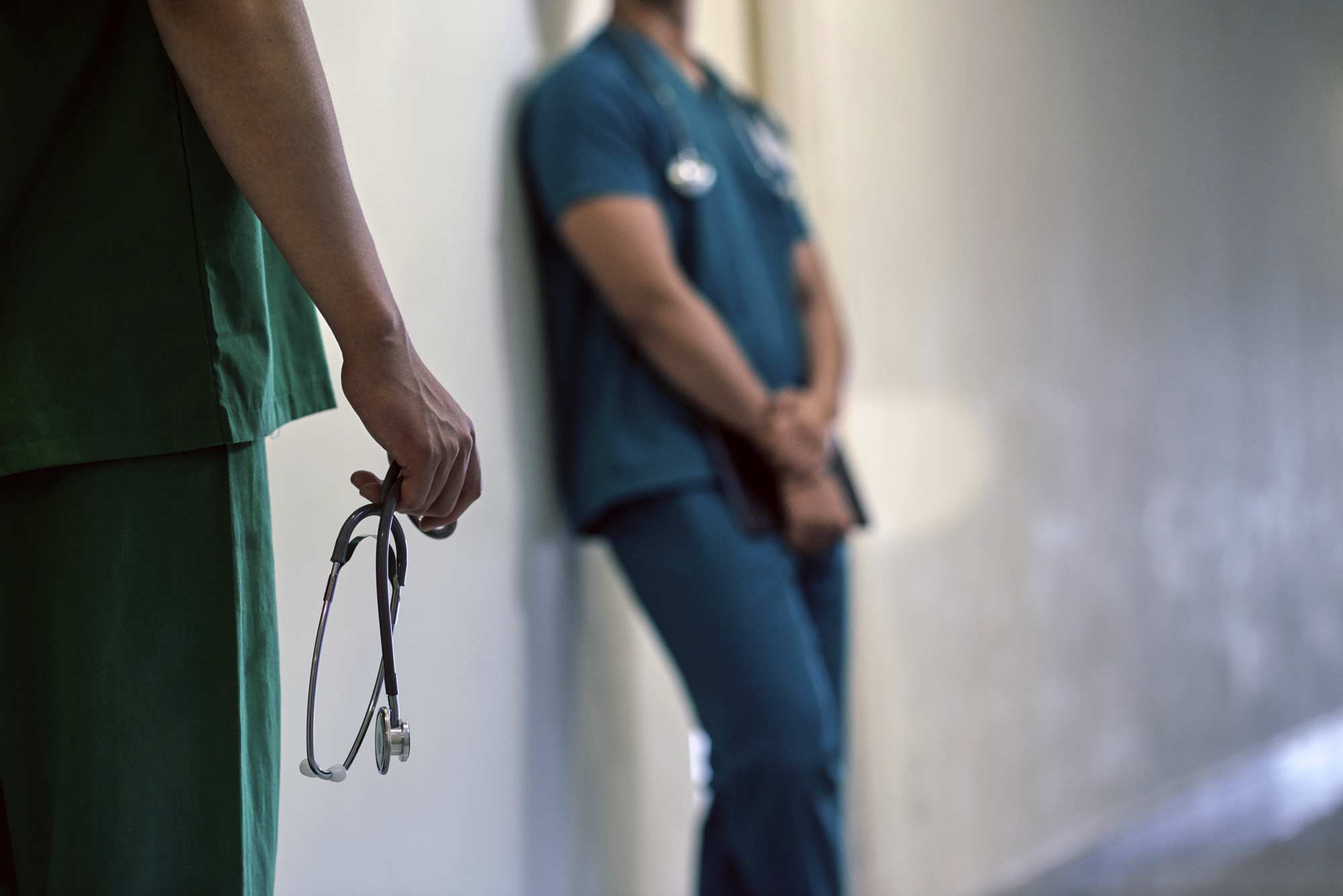Find the latest information on the University’s response to the coronavirus here.
Splints, bandages, gauze and bacitracin – basic items of first aid. But what happens to the work of health care providers and emergency responders if they’re injured in ways not visible to the naked eye?
These “stress injuries” – which can dramatically alter health care providers’ ability to live, work and cope, and almost certainly affect the quality and safety of their work – usually come from four sources, said Richard Westphal, Woodard Professor of Nursing and a psychiatric mental health nurse practitioner in the University of Virginia’s School of Nursing.
Those in the fray of emergency response or on the front lines of a pandemic may experience a threat to their life or a trauma that provokes in them terror, horror or helplessness. They may experience the poignant loss of a cherished person, a way of living, or feel they’ve lost a part of their soul. They may feel great conflict after witnessing something that violates a deeply held belief or value (also called moral distress); and, finally, they may feel deep and debilitating fatigue as a result of all these things, which is an accumulation of stress from multiple sources without time for sufficient rest and recovery.
And with the advent of COVID-19, conditions are ripe, Westphal said, for stress injuries to occur in precisely those individuals tasked with helping infected patents and those who fear it.
“There may be no broken bones to fix, or surgeries to schedule,” Westphal said, “but people with stress injuries are living with a kind of mental injury that impacts literally everything they do. It’s as debilitating, if not more profound, than most physical injuries. We are living in a period of time when much has changed for each of us, and especially for front-line personnel, the risks are high.”
Westphal, who previously oversaw the U.S. Navy’s $117 million psychological health and traumatic brain injury programs, has offered a “Stress First Aid” course to firefighters, military personnel, police officers, nurses, physicians and others over the past 13 years. The approach – part of UVA Health’s Be Wise campaign – also helps improve working conditions, units’ cohesion and resilience, communication and interpersonal behaviors. It also gives health care and emergency response workers a map to mitigate the effects of stress.
Here are Westphal’s four tips for recognizing stress injury and how serious it might be.
Ready
Definition
- Adaptive coping
- Effective functioning
- Well-being
Features
- In control
- Calm and steady
- Getting the job done
- Playing
- Sense of humor
- Sleeping enough
- Ethical and moral behavior
Reacting
Definition
- Mild and translent distress or loss of function
Features
- Anxious
- Irritable, angry
- Worrying
- Cutting corners
- Poor sleep
- Poor mental focus
- Social isolation
- Too loud and hyperactive
Injured
Definition
- More severe and persistent distress or loss of function
Types
- Tramua
- Fatigue
- Grief
- Moral Injury
Features
- Loss of control
- Can't sleep
- Panic or rage
- Apathy
- Shame or guilt
Ill
Definition
- Clinical mental disorders
- Unhealed stress injuries
Types
- PTSD
- Depression
- Anxiety
- Substance abuse
Features
- Symptoms persist > 60 days after return from deployment
Learn to Recognize Stress Injuries
Stress injuries happen across a continuum [see graphic above]. Psychologically healthy individuals in the green zone are confident and ready in their roles, and when they face a stressful event, they’re able to get themselves back to baseline.
In the yellow, or reacting phase, individuals are in mild distress and feel a level of anxiety, irritability, anger and worry, and begin to lose focus as a result of their stress injury.
More dangerous are the orange and red levels, the point on the stress-injury spectrum where mental illness has taken root. People here are persistently unable to cope with day-to-day life, including work. They may face grief or experience moral distress that inhibits their ability to sleep, makes them feel out of control, panicked, or, on the other end of the scale, apathetic and utterly exhausted.
If you understand these levels, and can recognize them in others and in yourself, you’ll be able to purposefully find your way back to health through the use of peer support, talk therapy, self-care and other resources.
Remember Resilience and Well-Being
School of Nursing faculty members spend a lot of time talking about these topics with students and encouraging them to find a practice that works for them to keep their bodies and minds healthy. Doing that, instructors believe, will reduce the high levels of burnout and professional attrition that plague the health care professions. It’s a sea change from the time when many nursing and medical faculty members were taught that a stiff upper lip was the best defense against experiencing stress injuries.

Richard Westphal is Woodard Professor of Nursing and a psychiatric mental health nurse practitioner in the University of Virginia’s School of Nursing. (Photo by Dan Addison, University Communications)
Some basic rules apply, of course. Rest, good sleep and enough time to recover between shifts is a good starting place. So is avoiding excessive alcohol and eating to self-soothe. Other activities that promote resilience and well-being might include meditation, running, quilting, art, writing, t’ai chi, yoga – any activity that brings calm and meaning to the individual.
Some front-line workers at UVA Health have turned to writing COVID-19-related haiku.
In stressful times, even if individuals feel pressed for time, it’s even more important to carve out moments for these activities. The enormity of the situation calls for your body and mind to be properly functioning.
Instill Calm in Yourself and Others
This is a trait that many first responders and health care workers on the front lines have in abundance: they are good at keeping their breath, their hearts and their hands steady. But it’s not a sign of weakness to feel overwhelmed or panicked. If that happens, there is great benefit to doing a simple breathing exercise using the STOP methodology:
- Stop.
- Take slow deep breaths.
- Open up and observe how you feel.
- Proceed with intentional awareness, kindness, wise action.
A pause, too, often can bring us back to baseline. If you find you cannot calm yourself, you need to seek help and support from others quickly, before a stress injury takes root.
Look for Connection
This is critical. Whether at work, at home or in virtual spaces, humans crave and need connection. Make sure you’ve got a trusted person to talk you through any difficult cases or issues you’re facing.
With stress injuries, one of the first symptoms of a stress injury is when that health care providers are no longer able to recognize that they’re acting differently, and why peer support and having a “trusted other” is so critically important. Care providers need those who can say, “We’ve been working together for a long time, and I don’t know where your head is lately. So what’s going on?”
Have Confidence in Your Skills – But Don’t Be Afraid to Ask for Help
Nurses, physicians, respiratory therapists, emergency responders, and others are made for emergencies like COVID-19. They’ve trained for this, and understand how high the stakes are in this dramatic moment. But if someone feels themselves slipping into one of the orange or red zones, or observes a colleague slipping, they need to address it directly, in a nonjudgmental way, and ask for help. This is as critical as the work they do on the front lines.
If the nurse or first responder can’t or won’t recognize their own stress injury and its cascade of ill effects, it’s up to their colleagues or managers to identify the injury and help provide a plotline back to health. That may mean an honest look at the issues adding to the stress, frank conversations, and connecting individuals with professional help and resources so they can make their way back into the green zone.
When health care providers support people who are stressed, and those around them, they ultimately improve patient care while supporting their own health and wellness, too.
Media Contact
Article Information
March 31, 2020
/content/healing-hurt-doesnt-show-4-tips-stress-injury-health-care-workers

